UTS Statistics 14 September 2018 Assignment on Cancer and HPV
VerifiedAdded on 2023/06/07
|13
|1890
|212
Homework Assignment
AI Summary
This statistics assignment presents a comprehensive analysis of death rates and risk factors. The assignment begins by calculating and comparing crude death rates for Australia and Saudi Arabia, followed by age-specific death rates due to cancer. It then delves into age-standardized death rates, calculating them for both countries and discussing the implications. The assignment further explores risk ratios, absolute differences, and attributable fractions related to infant mortality and birthweight. Finally, it examines the relationship between smoking and HPV status, including the impact of lifetime sexual partners as an effect modifier, utilizing contingency tables and risk ratios to draw conclusions about the association between these variables.

Statistics
Student Name:
Instructor Name:
Course Number:
14 September 2018
Student Name:
Instructor Name:
Course Number:
14 September 2018
Paraphrase This Document
Need a fresh take? Get an instant paraphrase of this document with our AI Paraphraser
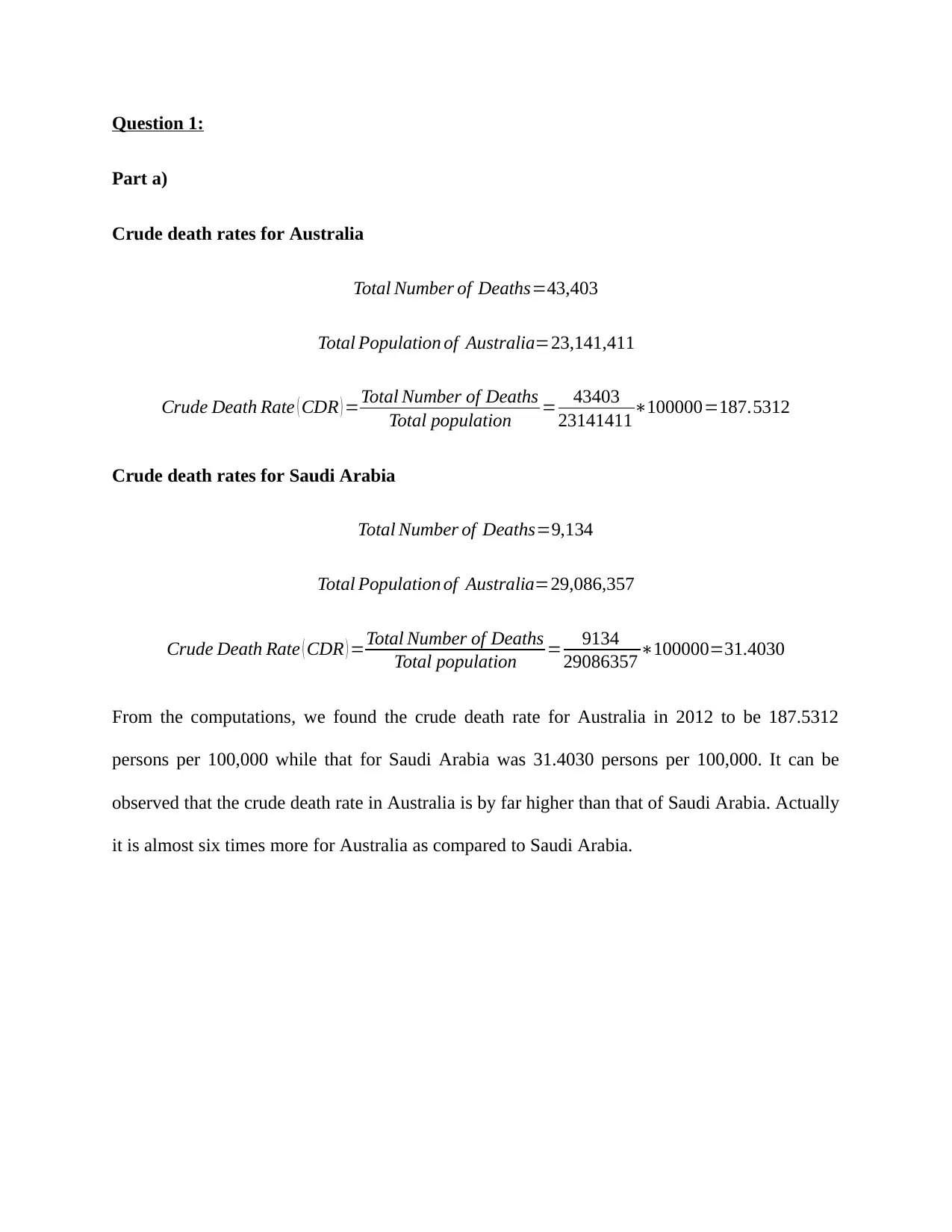
Question 1:
Part a)
Crude death rates for Australia
Total Number of Deaths=43,403
Total Population of Australia=23,141,411
Crude Death Rate ( CDR ) =Total Number of Deaths
Total population = 43403
23141411∗100000=187.5312
Crude death rates for Saudi Arabia
Total Number of Deaths=9,134
Total Population of Australia=29,086,357
Crude Death Rate ( CDR ) =Total Number of Deaths
Total population = 9134
29086357 ∗100000=31.4030
From the computations, we found the crude death rate for Australia in 2012 to be 187.5312
persons per 100,000 while that for Saudi Arabia was 31.4030 persons per 100,000. It can be
observed that the crude death rate in Australia is by far higher than that of Saudi Arabia. Actually
it is almost six times more for Australia as compared to Saudi Arabia.
Part a)
Crude death rates for Australia
Total Number of Deaths=43,403
Total Population of Australia=23,141,411
Crude Death Rate ( CDR ) =Total Number of Deaths
Total population = 43403
23141411∗100000=187.5312
Crude death rates for Saudi Arabia
Total Number of Deaths=9,134
Total Population of Australia=29,086,357
Crude Death Rate ( CDR ) =Total Number of Deaths
Total population = 9134
29086357 ∗100000=31.4030
From the computations, we found the crude death rate for Australia in 2012 to be 187.5312
persons per 100,000 while that for Saudi Arabia was 31.4030 persons per 100,000. It can be
observed that the crude death rate in Australia is by far higher than that of Saudi Arabia. Actually
it is almost six times more for Australia as compared to Saudi Arabia.
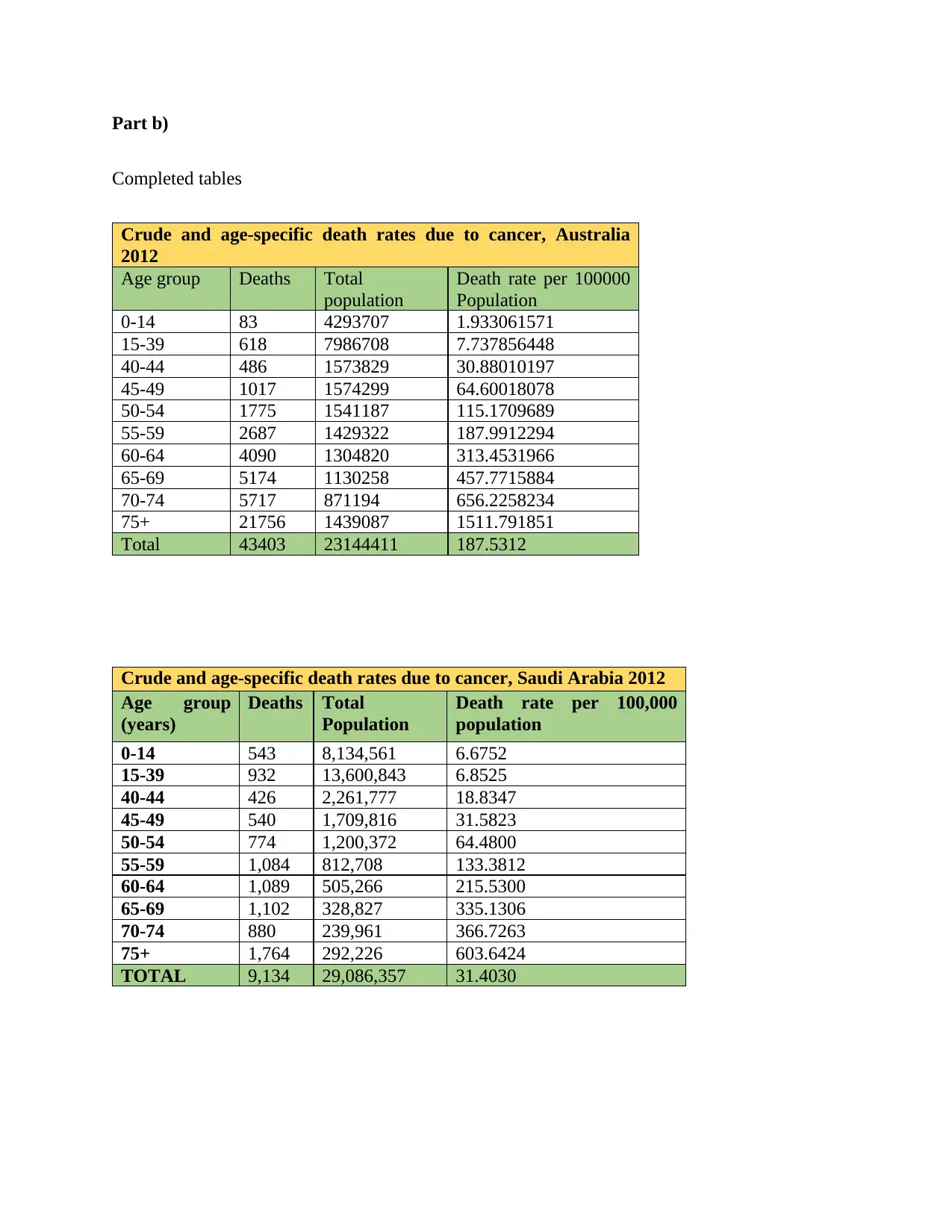
Part b)
Completed tables
Crude and age-specific death rates due to cancer, Australia
2012
Age group Deaths Total
population
Death rate per 100000
Population
0-14 83 4293707 1.933061571
15-39 618 7986708 7.737856448
40-44 486 1573829 30.88010197
45-49 1017 1574299 64.60018078
50-54 1775 1541187 115.1709689
55-59 2687 1429322 187.9912294
60-64 4090 1304820 313.4531966
65-69 5174 1130258 457.7715884
70-74 5717 871194 656.2258234
75+ 21756 1439087 1511.791851
Total 43403 23144411 187.5312
Crude and age-specific death rates due to cancer, Saudi Arabia 2012
Age group
(years)
Deaths Total
Population
Death rate per 100,000
population
0-14 543 8,134,561 6.6752
15-39 932 13,600,843 6.8525
40-44 426 2,261,777 18.8347
45-49 540 1,709,816 31.5823
50-54 774 1,200,372 64.4800
55-59 1,084 812,708 133.3812
60-64 1,089 505,266 215.5300
65-69 1,102 328,827 335.1306
70-74 880 239,961 366.7263
75+ 1,764 292,226 603.6424
TOTAL 9,134 29,086,357 31.4030
Completed tables
Crude and age-specific death rates due to cancer, Australia
2012
Age group Deaths Total
population
Death rate per 100000
Population
0-14 83 4293707 1.933061571
15-39 618 7986708 7.737856448
40-44 486 1573829 30.88010197
45-49 1017 1574299 64.60018078
50-54 1775 1541187 115.1709689
55-59 2687 1429322 187.9912294
60-64 4090 1304820 313.4531966
65-69 5174 1130258 457.7715884
70-74 5717 871194 656.2258234
75+ 21756 1439087 1511.791851
Total 43403 23144411 187.5312
Crude and age-specific death rates due to cancer, Saudi Arabia 2012
Age group
(years)
Deaths Total
Population
Death rate per 100,000
population
0-14 543 8,134,561 6.6752
15-39 932 13,600,843 6.8525
40-44 426 2,261,777 18.8347
45-49 540 1,709,816 31.5823
50-54 774 1,200,372 64.4800
55-59 1,084 812,708 133.3812
60-64 1,089 505,266 215.5300
65-69 1,102 328,827 335.1306
70-74 880 239,961 366.7263
75+ 1,764 292,226 603.6424
TOTAL 9,134 29,086,357 31.4030
⊘ This is a preview!⊘
Do you want full access?
Subscribe today to unlock all pages.

Trusted by 1+ million students worldwide
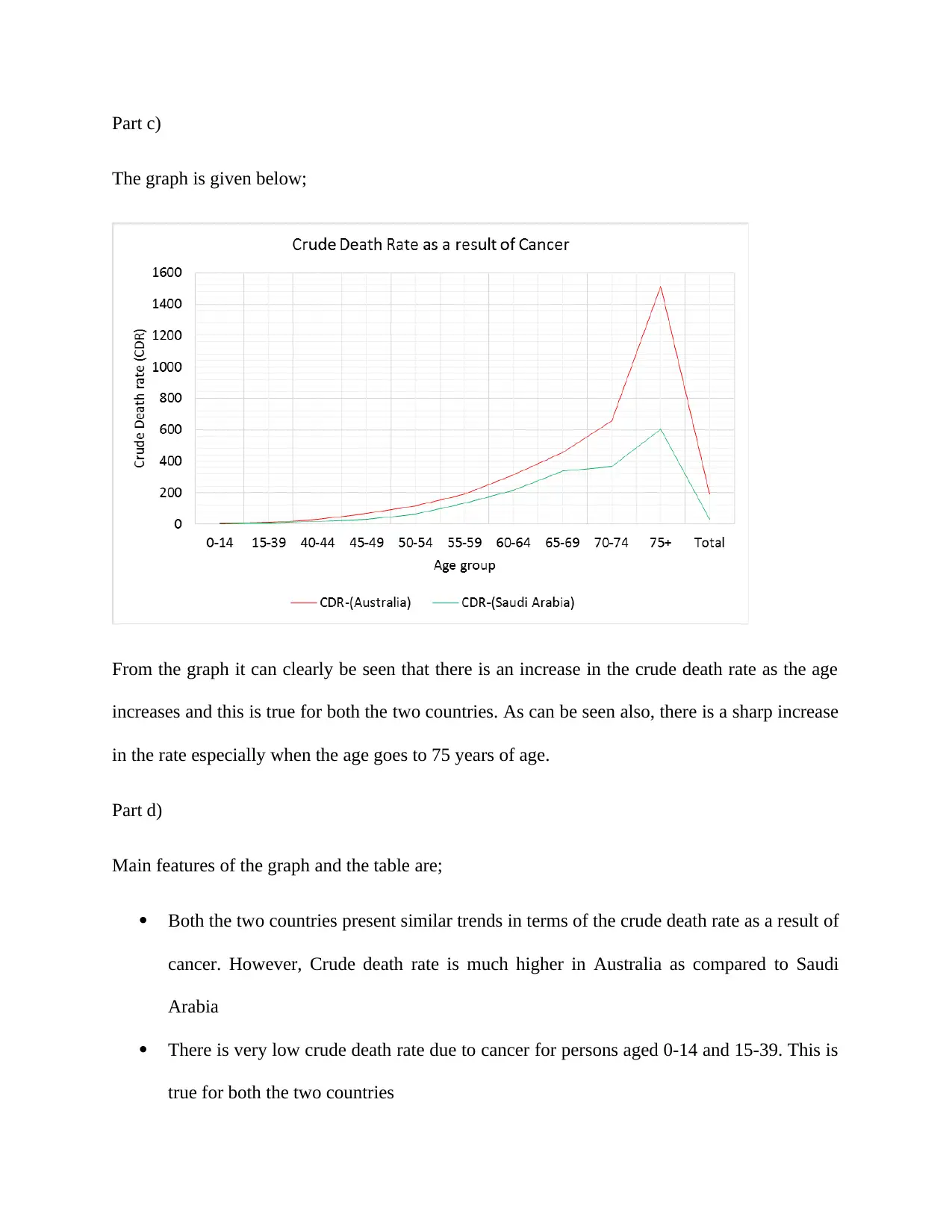
Part c)
The graph is given below;
From the graph it can clearly be seen that there is an increase in the crude death rate as the age
increases and this is true for both the two countries. As can be seen also, there is a sharp increase
in the rate especially when the age goes to 75 years of age.
Part d)
Main features of the graph and the table are;
Both the two countries present similar trends in terms of the crude death rate as a result of
cancer. However, Crude death rate is much higher in Australia as compared to Saudi
Arabia
There is very low crude death rate due to cancer for persons aged 0-14 and 15-39. This is
true for both the two countries
The graph is given below;
From the graph it can clearly be seen that there is an increase in the crude death rate as the age
increases and this is true for both the two countries. As can be seen also, there is a sharp increase
in the rate especially when the age goes to 75 years of age.
Part d)
Main features of the graph and the table are;
Both the two countries present similar trends in terms of the crude death rate as a result of
cancer. However, Crude death rate is much higher in Australia as compared to Saudi
Arabia
There is very low crude death rate due to cancer for persons aged 0-14 and 15-39. This is
true for both the two countries
Paraphrase This Document
Need a fresh take? Get an instant paraphrase of this document with our AI Paraphraser
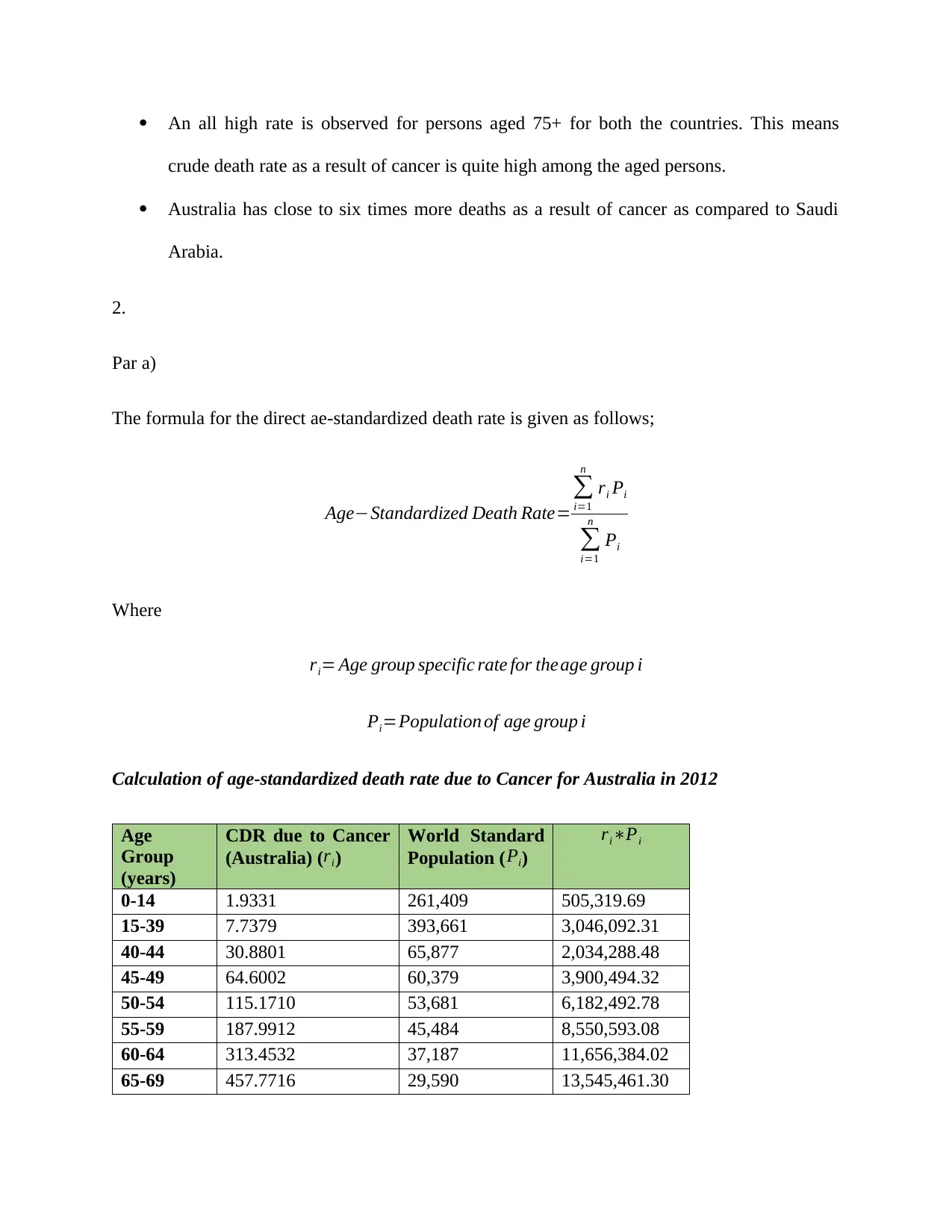
An all high rate is observed for persons aged 75+ for both the countries. This means
crude death rate as a result of cancer is quite high among the aged persons.
Australia has close to six times more deaths as a result of cancer as compared to Saudi
Arabia.
2.
Par a)
The formula for the direct ae-standardized death rate is given as follows;
Age−Standardized Death Rate=
∑
i=1
n
ri Pi
∑
i=1
n
Pi
Where
ri= Age group specific rate for the age group i
Pi=Population of age group i
Calculation of age-standardized death rate due to Cancer for Australia in 2012
Age
Group
(years)
CDR due to Cancer
(Australia) (ri)
World Standard
Population ( Pi)
ri∗Pi
0-14 1.9331 261,409 505,319.69
15-39 7.7379 393,661 3,046,092.31
40-44 30.8801 65,877 2,034,288.48
45-49 64.6002 60,379 3,900,494.32
50-54 115.1710 53,681 6,182,492.78
55-59 187.9912 45,484 8,550,593.08
60-64 313.4532 37,187 11,656,384.02
65-69 457.7716 29,590 13,545,461.30
crude death rate as a result of cancer is quite high among the aged persons.
Australia has close to six times more deaths as a result of cancer as compared to Saudi
Arabia.
2.
Par a)
The formula for the direct ae-standardized death rate is given as follows;
Age−Standardized Death Rate=
∑
i=1
n
ri Pi
∑
i=1
n
Pi
Where
ri= Age group specific rate for the age group i
Pi=Population of age group i
Calculation of age-standardized death rate due to Cancer for Australia in 2012
Age
Group
(years)
CDR due to Cancer
(Australia) (ri)
World Standard
Population ( Pi)
ri∗Pi
0-14 1.9331 261,409 505,319.69
15-39 7.7379 393,661 3,046,092.31
40-44 30.8801 65,877 2,034,288.48
45-49 64.6002 60,379 3,900,494.32
50-54 115.1710 53,681 6,182,492.78
55-59 187.9912 45,484 8,550,593.08
60-64 313.4532 37,187 11,656,384.02
65-69 457.7716 29,590 13,545,461.30

70-74 656.2258 22,092 14,497,340.89
75+ 1511.7919 30,640 46,321,302.33
Total 187.5312 1,000,000 110,239,769.19
Directly Age-Standardized Death Rate due to Cancer for Australia in 2012,
∑
i=1
n
ri Pi
∑
i=1
n
Pi
¿ 110239769.19
1000000
¿ 110.240 per 100,000 population
Therefore the age-standardized death rate as a result of cancer for Australia in 2012 is 110.240
per persons 100,000 population.
Calculation of age-standardized death rate due to Cancer for Saudi Arabia in 2012
Age Group
(years)
CDR due to Cancer
(Australia) (ri)
World Standard
Population ( Pi)
ri∗Pi
0-14 6.6752 261,409 1,744,963.09
15-39 6.8525 393,661 2,697,568.47
40-44 18.8347 65,877 1,240,776.70
45-49 31.5823 60,379 1,906,910.45
50-54 64.4800 53,681 3,461,351.48
55-59 133.3812 45,484 6,066,712.28
60-64 215.5300 37,187 8,014,915.51
65-69 335.1306 29,590 9,916,515.37
70-74 366.7263 22,092 8,101,716.53
75+ 603.6424 30,640 18,495,602.72
Total 31.4030 1,000,000 61,647,032.59
Directly Age-Standardized Death Rate due to Cancer for Saudi Arabia in 2012,
75+ 1511.7919 30,640 46,321,302.33
Total 187.5312 1,000,000 110,239,769.19
Directly Age-Standardized Death Rate due to Cancer for Australia in 2012,
∑
i=1
n
ri Pi
∑
i=1
n
Pi
¿ 110239769.19
1000000
¿ 110.240 per 100,000 population
Therefore the age-standardized death rate as a result of cancer for Australia in 2012 is 110.240
per persons 100,000 population.
Calculation of age-standardized death rate due to Cancer for Saudi Arabia in 2012
Age Group
(years)
CDR due to Cancer
(Australia) (ri)
World Standard
Population ( Pi)
ri∗Pi
0-14 6.6752 261,409 1,744,963.09
15-39 6.8525 393,661 2,697,568.47
40-44 18.8347 65,877 1,240,776.70
45-49 31.5823 60,379 1,906,910.45
50-54 64.4800 53,681 3,461,351.48
55-59 133.3812 45,484 6,066,712.28
60-64 215.5300 37,187 8,014,915.51
65-69 335.1306 29,590 9,916,515.37
70-74 366.7263 22,092 8,101,716.53
75+ 603.6424 30,640 18,495,602.72
Total 31.4030 1,000,000 61,647,032.59
Directly Age-Standardized Death Rate due to Cancer for Saudi Arabia in 2012,
⊘ This is a preview!⊘
Do you want full access?
Subscribe today to unlock all pages.

Trusted by 1+ million students worldwide

∑
i=1
n
ri Pi
∑
i=1
n
Pi
¿ 61647032.59
1000000
¿ 61.647 per 100,000 population
Therefore the age-standardized death rate as a result of cancer for Saudi Arabia in 2012 is 61.647
persons per 100,000 population.
Part b)
The following findings were noted in the calculations;
We observed that the CDR for Australia was 187.5312 per 100,000 persons while that of
Saudi Arabia was 31.4030 per 100,000 persons.
The directly age-standardized death rate for Australia was found to be 110.240 per
100,000 persons while that of Saudi Arabia was 61.647 per 100,000 persons.
Discussion
The CDR for Australia was by far higher than the Age-Standardized death rate. A drastic
reduction was noted which however was not the case for Saudi Arabia. The Saudi Arabian case
is different in the sense that the CDR is less than the Age-Standardized death rate. This means
that risk of deaths as a result of cancer are minimized in Australia when Age-Standardized death
rate is applied but the risk is kind of doubled for Saudi Arabian case
i=1
n
ri Pi
∑
i=1
n
Pi
¿ 61647032.59
1000000
¿ 61.647 per 100,000 population
Therefore the age-standardized death rate as a result of cancer for Saudi Arabia in 2012 is 61.647
persons per 100,000 population.
Part b)
The following findings were noted in the calculations;
We observed that the CDR for Australia was 187.5312 per 100,000 persons while that of
Saudi Arabia was 31.4030 per 100,000 persons.
The directly age-standardized death rate for Australia was found to be 110.240 per
100,000 persons while that of Saudi Arabia was 61.647 per 100,000 persons.
Discussion
The CDR for Australia was by far higher than the Age-Standardized death rate. A drastic
reduction was noted which however was not the case for Saudi Arabia. The Saudi Arabian case
is different in the sense that the CDR is less than the Age-Standardized death rate. This means
that risk of deaths as a result of cancer are minimized in Australia when Age-Standardized death
rate is applied but the risk is kind of doubled for Saudi Arabian case
Paraphrase This Document
Need a fresh take? Get an instant paraphrase of this document with our AI Paraphraser
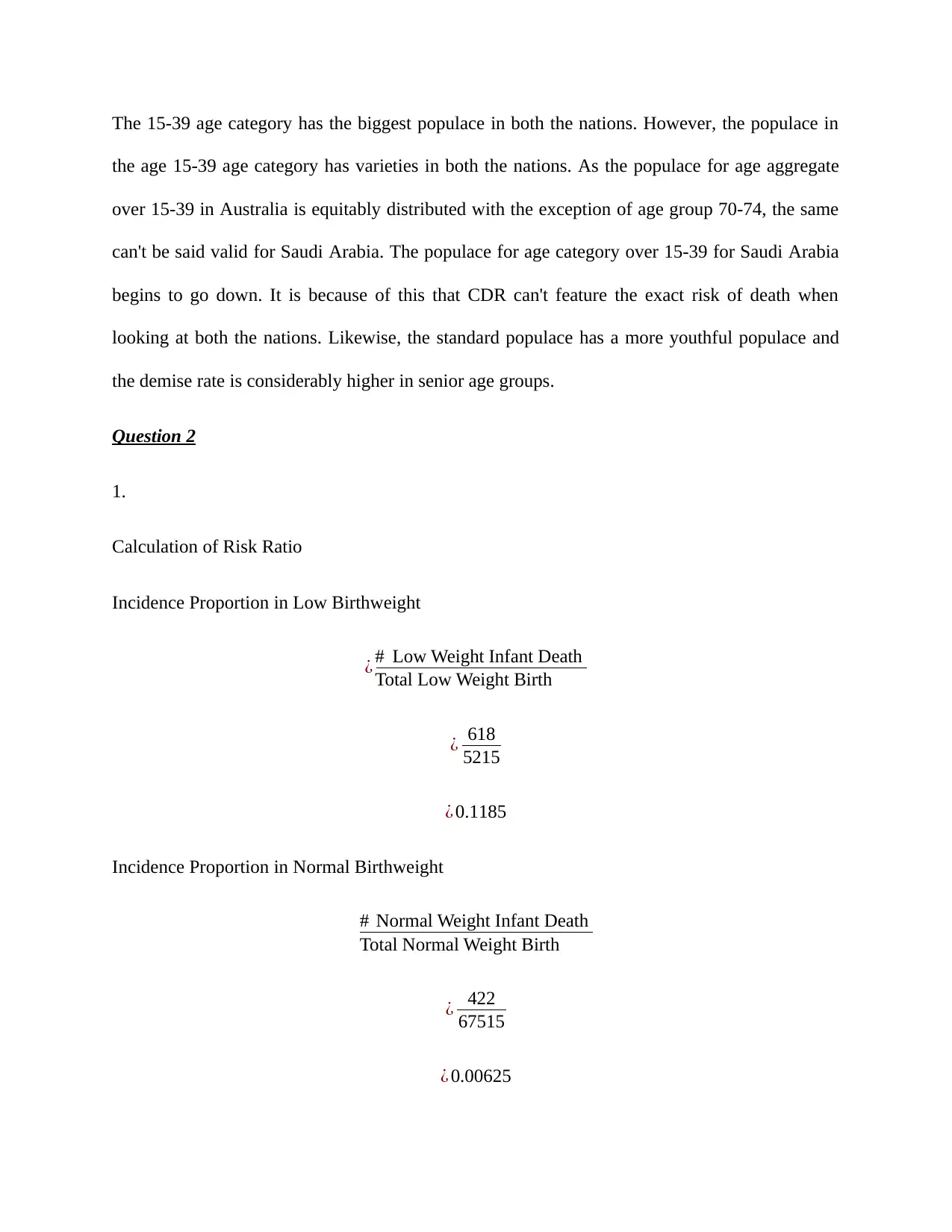
The 15-39 age category has the biggest populace in both the nations. However, the populace in
the age 15-39 age category has varieties in both the nations. As the populace for age aggregate
over 15-39 in Australia is equitably distributed with the exception of age group 70-74, the same
can't be said valid for Saudi Arabia. The populace for age category over 15-39 for Saudi Arabia
begins to go down. It is because of this that CDR can't feature the exact risk of death when
looking at both the nations. Likewise, the standard populace has a more youthful populace and
the demise rate is considerably higher in senior age groups.
Question 2
1.
Calculation of Risk Ratio
Incidence Proportion in Low Birthweight
¿ # Low Weight Infant Death
Total Low Weight Birth
¿ 618
5215
¿ 0.1185
Incidence Proportion in Normal Birthweight
# Normal Weight Infant Death
Total Normal Weight Birth
¿ 422
67515
¿ 0.00625
the age 15-39 age category has varieties in both the nations. As the populace for age aggregate
over 15-39 in Australia is equitably distributed with the exception of age group 70-74, the same
can't be said valid for Saudi Arabia. The populace for age category over 15-39 for Saudi Arabia
begins to go down. It is because of this that CDR can't feature the exact risk of death when
looking at both the nations. Likewise, the standard populace has a more youthful populace and
the demise rate is considerably higher in senior age groups.
Question 2
1.
Calculation of Risk Ratio
Incidence Proportion in Low Birthweight
¿ # Low Weight Infant Death
Total Low Weight Birth
¿ 618
5215
¿ 0.1185
Incidence Proportion in Normal Birthweight
# Normal Weight Infant Death
Total Normal Weight Birth
¿ 422
67515
¿ 0.00625

Risk Ratio= Incidence proportion∈low birthweight
Incidence proportion∈normal birthweight = 0.1185
0.00625 =18.9593
From the above, we can observe that the risk ratio is 18.9593 times
2.
The absolute difference in incidence of infant mortality by birthweight category is calculated as
given below;
Absolute difference of infant mortality by birthweight,
¿ Incidence∈low birthweight – Incidence∈normal birthweight
¿ 0.11850 – 0.00625=0.11225=11.225%
Thus there is a 11.225% likelihood of infant mortality at low birthweight as compared to the
normal birthweight.
3.
Calculation of the proportion of deaths among low birthweight infants that would have not
occurred in the absence of low birthweight
Attributable Fraction is calculated by the following formula,
¿ Absolute Risk
Incidence in Exposed =0.11225
0.11850 =0.9473=94.73 %
This means that there is a 94.73% likelihood of infant mortality to arise from low birthweight.
4.
The overall incidence of infant mortality is calculated as under:
Incidence proportion∈normal birthweight = 0.1185
0.00625 =18.9593
From the above, we can observe that the risk ratio is 18.9593 times
2.
The absolute difference in incidence of infant mortality by birthweight category is calculated as
given below;
Absolute difference of infant mortality by birthweight,
¿ Incidence∈low birthweight – Incidence∈normal birthweight
¿ 0.11850 – 0.00625=0.11225=11.225%
Thus there is a 11.225% likelihood of infant mortality at low birthweight as compared to the
normal birthweight.
3.
Calculation of the proportion of deaths among low birthweight infants that would have not
occurred in the absence of low birthweight
Attributable Fraction is calculated by the following formula,
¿ Absolute Risk
Incidence in Exposed =0.11225
0.11850 =0.9473=94.73 %
This means that there is a 94.73% likelihood of infant mortality to arise from low birthweight.
4.
The overall incidence of infant mortality is calculated as under:
⊘ This is a preview!⊘
Do you want full access?
Subscribe today to unlock all pages.

Trusted by 1+ million students worldwide
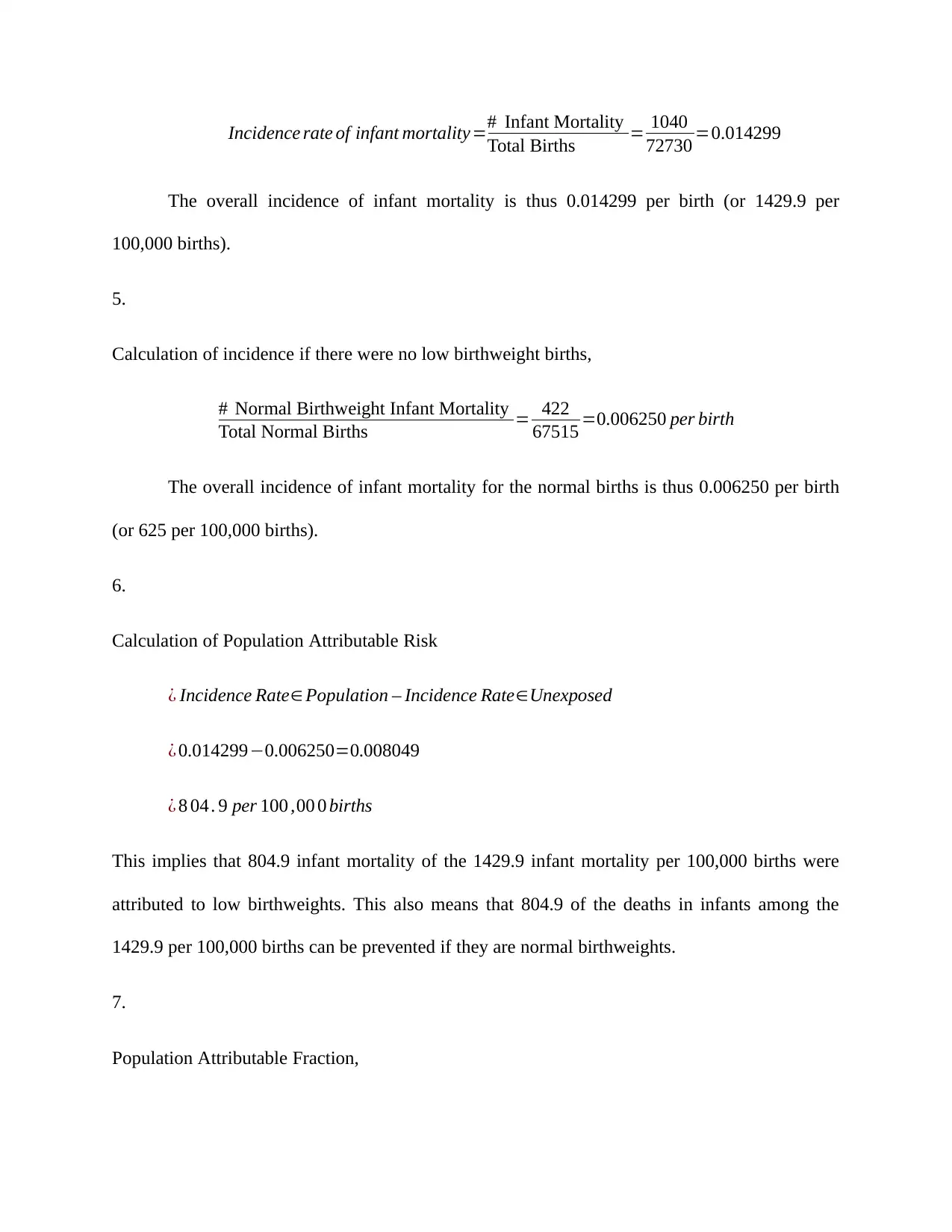
Incidence rate of infant mortality=# Infant Mortality
Total Births = 1040
72730 =0.014299
The overall incidence of infant mortality is thus 0.014299 per birth (or 1429.9 per
100,000 births).
5.
Calculation of incidence if there were no low birthweight births,
# Normal Birthweight Infant Mortality
Total Normal Births = 422
67515 =0.006250 per birth
The overall incidence of infant mortality for the normal births is thus 0.006250 per birth
(or 625 per 100,000 births).
6.
Calculation of Population Attributable Risk
¿ Incidence Rate∈ Population – Incidence Rate∈Unexposed
¿ 0.014299−0.006250=0.008049
¿ 8 04 . 9 per 100 ,00 0 births
This implies that 804.9 infant mortality of the 1429.9 infant mortality per 100,000 births were
attributed to low birthweights. This also means that 804.9 of the deaths in infants among the
1429.9 per 100,000 births can be prevented if they are normal birthweights.
7.
Population Attributable Fraction,
Total Births = 1040
72730 =0.014299
The overall incidence of infant mortality is thus 0.014299 per birth (or 1429.9 per
100,000 births).
5.
Calculation of incidence if there were no low birthweight births,
# Normal Birthweight Infant Mortality
Total Normal Births = 422
67515 =0.006250 per birth
The overall incidence of infant mortality for the normal births is thus 0.006250 per birth
(or 625 per 100,000 births).
6.
Calculation of Population Attributable Risk
¿ Incidence Rate∈ Population – Incidence Rate∈Unexposed
¿ 0.014299−0.006250=0.008049
¿ 8 04 . 9 per 100 ,00 0 births
This implies that 804.9 infant mortality of the 1429.9 infant mortality per 100,000 births were
attributed to low birthweights. This also means that 804.9 of the deaths in infants among the
1429.9 per 100,000 births can be prevented if they are normal birthweights.
7.
Population Attributable Fraction,
Paraphrase This Document
Need a fresh take? Get an instant paraphrase of this document with our AI Paraphraser
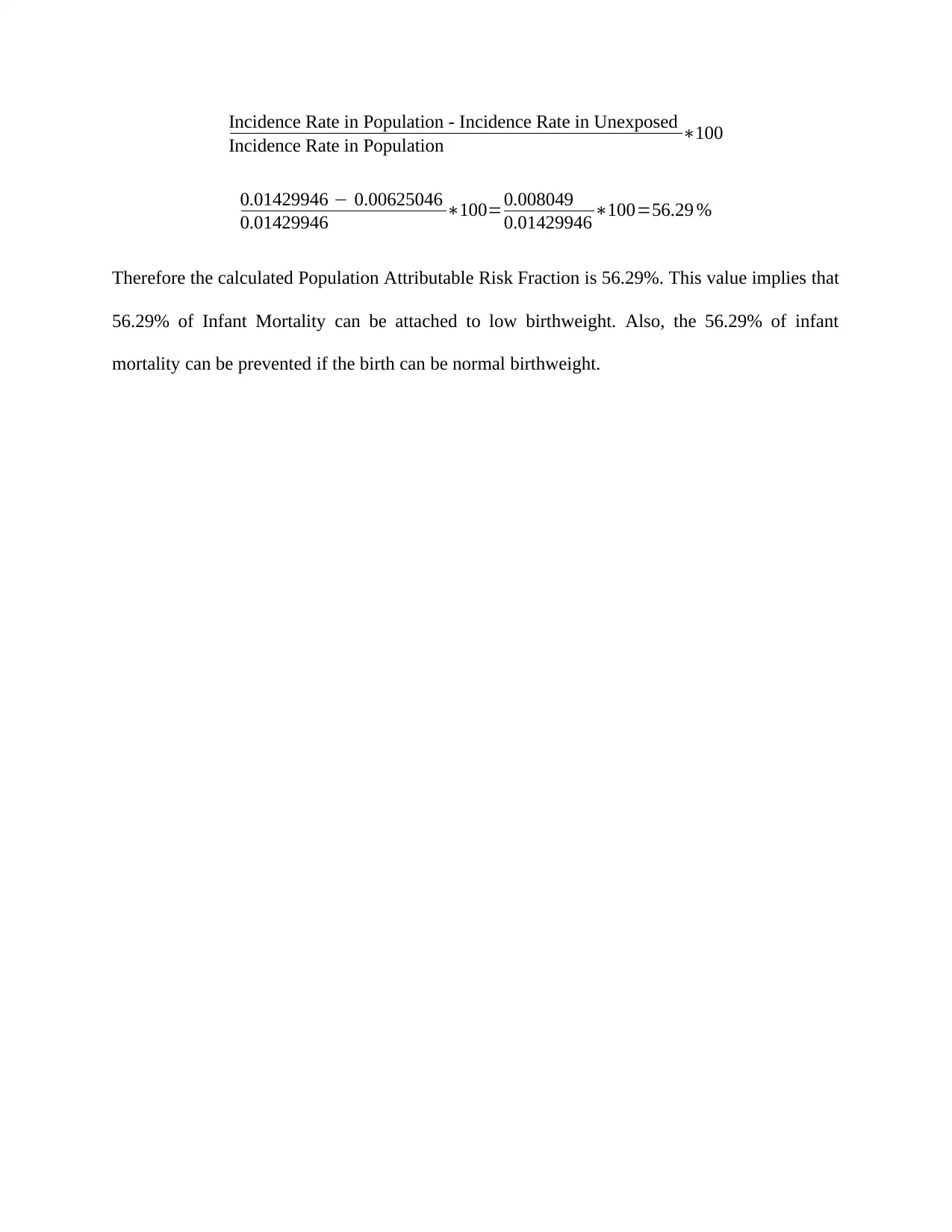
Incidence Rate in Population - Incidence Rate in Unexposed
Incidence Rate in Population ∗100
0.01429946 − 0.00625046
0.01429946 ∗100=0.008049
0.01429946 ∗100=56.29 %
Therefore the calculated Population Attributable Risk Fraction is 56.29%. This value implies that
56.29% of Infant Mortality can be attached to low birthweight. Also, the 56.29% of infant
mortality can be prevented if the birth can be normal birthweight.
Incidence Rate in Population ∗100
0.01429946 − 0.00625046
0.01429946 ∗100=0.008049
0.01429946 ∗100=56.29 %
Therefore the calculated Population Attributable Risk Fraction is 56.29%. This value implies that
56.29% of Infant Mortality can be attached to low birthweight. Also, the 56.29% of infant
mortality can be prevented if the birth can be normal birthweight.
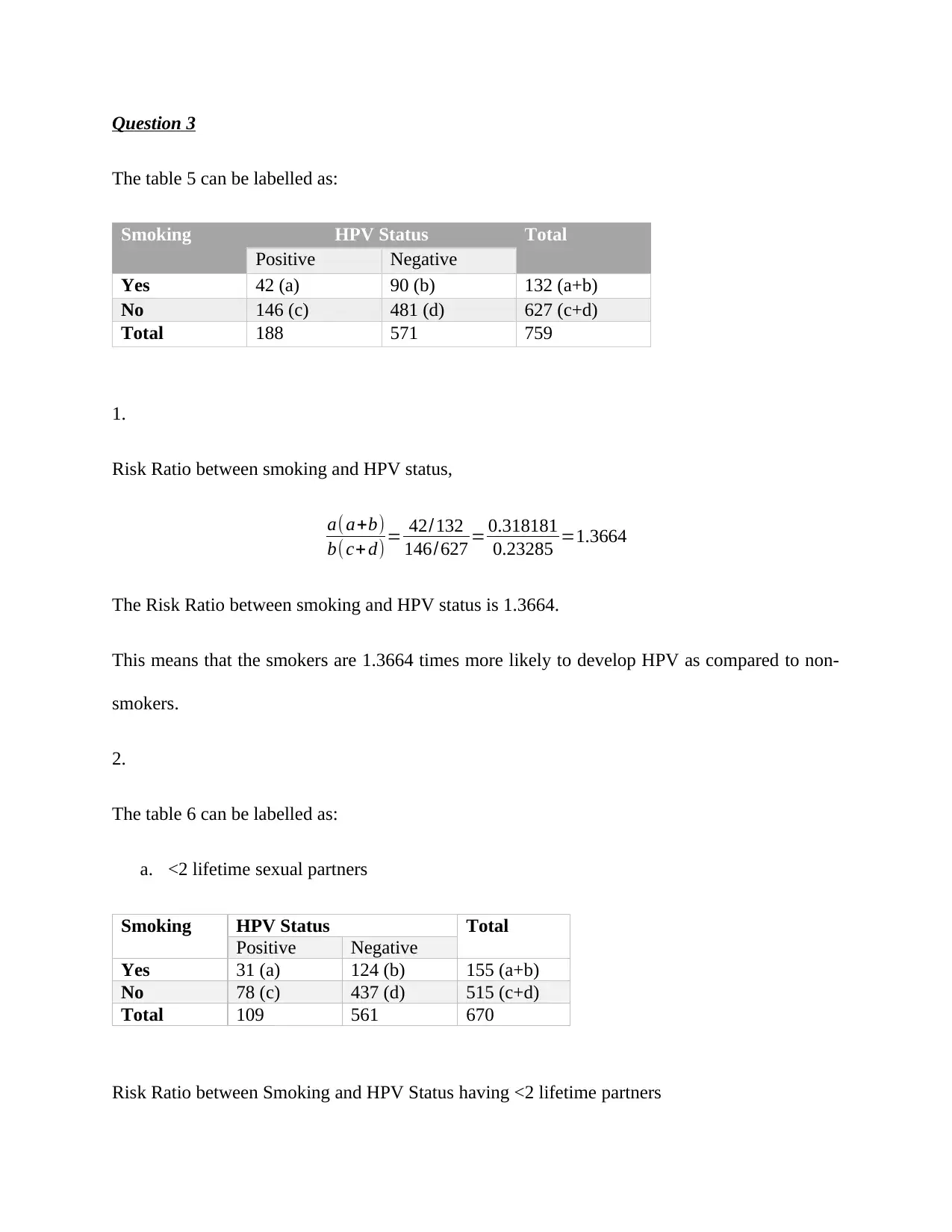
Question 3
The table 5 can be labelled as:
Smoking HPV Status Total
Positive Negative
Yes 42 (a) 90 (b) 132 (a+b)
No 146 (c) 481 (d) 627 (c+d)
Total 188 571 759
1.
Risk Ratio between smoking and HPV status,
a(a+b)
b(c+ d) = 42/132
146/627 = 0.318181
0.23285 =1.3664
The Risk Ratio between smoking and HPV status is 1.3664.
This means that the smokers are 1.3664 times more likely to develop HPV as compared to non-
smokers.
2.
The table 6 can be labelled as:
a. <2 lifetime sexual partners
Smoking HPV Status Total
Positive Negative
Yes 31 (a) 124 (b) 155 (a+b)
No 78 (c) 437 (d) 515 (c+d)
Total 109 561 670
Risk Ratio between Smoking and HPV Status having <2 lifetime partners
The table 5 can be labelled as:
Smoking HPV Status Total
Positive Negative
Yes 42 (a) 90 (b) 132 (a+b)
No 146 (c) 481 (d) 627 (c+d)
Total 188 571 759
1.
Risk Ratio between smoking and HPV status,
a(a+b)
b(c+ d) = 42/132
146/627 = 0.318181
0.23285 =1.3664
The Risk Ratio between smoking and HPV status is 1.3664.
This means that the smokers are 1.3664 times more likely to develop HPV as compared to non-
smokers.
2.
The table 6 can be labelled as:
a. <2 lifetime sexual partners
Smoking HPV Status Total
Positive Negative
Yes 31 (a) 124 (b) 155 (a+b)
No 78 (c) 437 (d) 515 (c+d)
Total 109 561 670
Risk Ratio between Smoking and HPV Status having <2 lifetime partners
⊘ This is a preview!⊘
Do you want full access?
Subscribe today to unlock all pages.

Trusted by 1+ million students worldwide
1 out of 13
Related Documents
Your All-in-One AI-Powered Toolkit for Academic Success.
+13062052269
info@desklib.com
Available 24*7 on WhatsApp / Email
![[object Object]](/_next/static/media/star-bottom.7253800d.svg)
Unlock your academic potential
Copyright © 2020–2026 A2Z Services. All Rights Reserved. Developed and managed by ZUCOL.





